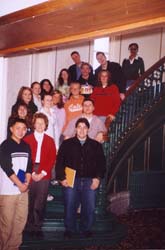
Home
- Artifacts
- Buildings & Businesses
- Churches
- Holidays & Celebrations
- Counties/Locations
- Delta College
- Early Settlers
- Ethnic Background
- Local, Michigan, U.S. and World Events
- Family Genealogy
- Farming
- Libraries & Museums
- Local Sites
- Logging
- Musicians, Artists & Famous People
- Nature, Weather & Four Seasons
- Railroads
- Schools
- Sports
 |
As I drove down Warren Avenue on my way to the Castle Museum of Saginaw one autumn afternoon, I saw green copper towers looming high above modern-day places of business. I ascended the steps to the museum and I couldn't help looking up as I glanced around at my surroundings. Gargoyles made of concrete to keep out evil are perched at the extremity of the roof and peer down with ancient faces, baring their sharp teeth. They look at you almost saying, "What do you want? We have nothing here for you. Now, LEAVE!" The Castle Museum is a huge building that does, in fact, look like a castle of ancient Europe. I began to anticipatethoughts of history and the experience I was about to have as I entered this mystical building. Photo by Mary B. Looby
When I walked in the heavy wooden doors, I heard the sounds of echoes in the corridors and I smelled the scent of time gone by as the concrete faces of ancient Native American tribal members looked down at me. The walls are at least ten feet in height and made of a cinnamon and black kaleidoscopic marble that is cool to the touch.
 |
As I turned to my left, I could not see all the way down to the end of the main portal, because in center stage there is one of the first cars of the automobile industry blocking my view. I turned left again and began to walk. I came to an open room filled with natural light coming from one of the many windows in this spherical room. On the far side of the room, there is a staircase. This is no ordinary staircase. It resembles one from "Gone With the Wind" or some other fairy tale or fantasy story. It is almost as high as the ceiling and winds all the way around the room, as if it were taking you to the clouds. This stairwell is made of wood, pine I imagine, and the rungs and steps are painted white while the smooth banister is a deep shade of emerald.
At the top of the stairs, I came to yet another point in time: the farming industry of the nineteenth century. This room gives details of what seasons the crops in and around Saginaw brought in the most profit. It even gives a detailed map of where the early farms in Saginaw were, and what streets they were on. I walked downstairs into the next room where I found facts about the history of the United States Postal Service. I was greeted by a one-hundred and twenty-pound red, white, and blue porcelain plaque bearing the coat of arms of the postal service.
To my right was another set of stairs. As I walked up them, I felt as though I was entering forbidden territory. I saw a dark walkway, so dark I could not see my hand in front of my face, and so small I could not outstretch my arms even half way on both sides. This hall is called "the catwalk". It was used for postal workers to act as spies on their fellow workers by peering down through small slits on the walls to see if anyone was stealing from the parcels brought in. I could almost hear them with the postmaster talking to one of the workers up there: "I think Charlie may possibly be pocketing some cash from that brown sachel . . . . We had better call the constable."
I then went downstairs to see the history of Saginaw. There I saw lighted enclosed glass display cases entitled "A Century of Style," showing clothes women wore from the 1880s to the 1980s. It was very mysterious down here. It smelled of mildew and was very dark. The only light was that which was coming from those display cases. I wondered if I would see a poltergeist, or maybe an old ghost, who is still between worlds. There was even a display case about the gang-saw the lumber men used in the lumbering industry.
I walked away from this amazing, yet chilling span of time feeling that not everything is right with the world--nor was it ever. I stepped into the daylight and saw the cars of today driving past, and I almost wanted to observe a horse-drawn buggy clip-clopping past, just to keep me in this frame of mind.
I drove away from this experience with a bit more knowledge of history, and a strange appreciation for my life in all its complexity. I looked into my rear-view mirror and I saw them: the green copper towers and the gargoyles, and I still smelled the scent of time gone by. I examine the thoughts running through my head about the history I learned about, and the experience I had on that autumn afternoon.
| The written and visual works in Mid-Michigan Remembers-Stories about Us were chosen on the basis of their quality, diversity, community interest and appeal. Views expressed do not necessarily reflect those of the College. This space is provided as a service by Delta College. |